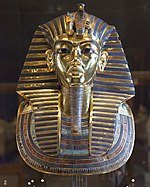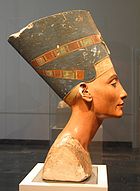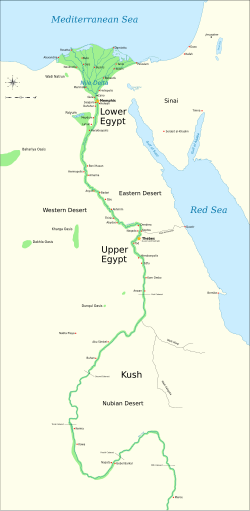Portal:Ancient Egypt
Showcased content about Ancient EgyptAncient Egypt was a civilization of ancient North Africa, concentrated along the lower reaches of the Nile River, situated in the place that is now the country Egypt. Ancient Egyptian civilization followed prehistoric Egypt and coalesced around 3100 BC (according to conventional Egyptian chronology) with the political unification of Upper and Lower Egypt under Menes (often identified with Narmer). The history of ancient Egypt occurred as a series of stable kingdoms, separated by periods of relative instability known as Intermediate Periods: the Old Kingdom of the Early Bronze Age, the Middle Kingdom of the Middle Bronze Age and the New Kingdom of the Late Bronze Age. Egypt reached the pinnacle of its power in the New Kingdom, ruling much of Nubia and a sizable portion of the Near East, after which it entered a period of slow decline. During the course of its history Egypt was invaded or conquered by a number of foreign powers, including the Hyksos, the Libyans, the Nubians, the Assyrians, the Achaemenid Persians, and the Macedonians under the command of Alexander the Great. The Greek Ptolemaic Kingdom, formed in the aftermath of Alexander's death, ruled Egypt until 30 BC, when, under Cleopatra, it fell to the Roman Empire and became a Roman province. The success of ancient Egyptian civilization came partly from its ability to adapt to the conditions of the Nile River valley for agriculture. The predictable flooding and controlled irrigation of the fertile valley produced surplus crops, which supported a more dense population, and social development and culture. With resources to spare, the administration sponsored mineral exploitation of the valley and surrounding desert regions, the early development of an independent writing system, the organization of collective construction and agricultural projects, trade with surrounding regions, and a military intended to assert Egyptian dominance. Motivating and organizing these activities was a bureaucracy of elite scribes, religious leaders, and administrators under the control of a pharaoh, who ensured the cooperation and unity of the Egyptian people in the context of an elaborate system of religious beliefs.[1] The many achievements of the ancient Egyptians include the quarrying, surveying and construction techniques that supported the building of monumental pyramids, temples, and obelisks; a system of mathematics, a practical and effective system of medicine, irrigation systems and agricultural production techniques, the first known planked boats, Egyptian faience and glass technology, new forms of literature, and the earliest known peace treaty, made with the Hittites. Ancient Egypt has left a lasting legacy. Its art and architecture were widely copied, and its antiquities carried off to far corners of the world. Its monumental ruins have inspired the imaginations of travelers and writers for centuries. A new-found respect for antiquities and excavations in the early modern period by Europeans and Egyptians led to the scientific investigation of Egyptian civilization and a greater appreciation of its cultural legacy. Selected articleThe Nefertiti Bust is a 3300-year-old painted limestone bust of Nefertiti, the Great Royal Wife of the Egyptian Pharaoh Akhenaten and is one of the most copied works of ancient Egypt. Due to the bust, Nefertiti has become one of the most famous women from the ancient world as well as an icon of female beauty. It is believed to have been crafted in 1345 BC by the sculptor Thutmose. A German archeological team led by Ludwig Borchardt discovered the Nefertiti bust in 1912 in Thutmose's workshop in Amarna, Egypt. It has been kept at several locations in Germany since its discovery, including a salt mine in Merkers-Kieselbach, the Dahlem museum (then in West Berlin), the Egyptian Museum in Charlottenburg and the Altes Museum. It is currently on display at the Neues Museum, Berlin, where it was displayed before World War II. The Nefertiti bust has become a cultural symbol of Berlin, Germany as well as of ancient Egypt. It has also been the subject of an intense argument between Egypt and Germany over the Egyptian demands for its repatriation. It was dragged into controversies over the Body of Nerfertiti art exhibition and also by allegations regarding its authenticity. Selected pictureIn antiquity, Ancient Egypt was divided into two lands: Upper Egypt and Lower Egypt. To the south, it was bounded by the land of Kush, and to the East, the levant. Surrounded by harsh deserts, the river Nile was the lifeline of this ancient civilization. Did you know...
Selected biographyAhmose I (sometimes written Amosis I, "Amenes" and "Aahmes" and meaning Born of the Moon or Born of Yah) was a pharaoh of ancient Egypt and the founder of the Eighteenth dynasty. He was a member of the Theban royal house, the son of pharaoh Tao II Seqenenre and brother of the last pharaoh of the Seventeenth dynasty, King Kamose. During the reign of his father or grandfather, Thebes rebelled against the Hyksos, the rulers of Lower Egypt. When he was seven his father was killed, and he was about ten when his brother died of unknown causes, after reigning only three years. Ahmose I assumed the throne after the death of his brother, and upon coronation became known as Neb-Pehty-Re (The Lord of Strength is Re). During his reign, he completed the conquest and expulsion of the Hyksos from the delta region, restored Theban rule over the whole of Egypt and successfully reasserted Egyptian power in its formerly subject territories of Nubia and Canaan. He then reorganized the administration of the country, reopened quarries, mines and trade routes and began massive construction projects of a type that had not been undertaken since the time of the Middle Kingdom. This building program culminated in the construction of the last pyramid built by native Egyptian rulers. Ahmose's reign laid the foundations for the New Kingdom, under which Egyptian power reached its peak. Ahmose I's mummy was discovered in 1881 within the Deir el-Bahri Cache, located in the hills directly above the Mortuary Temple of Hatshepsut. He was interred along with the mummies of other 18th and 19th dynasty leaders Amenhotep I, Thutmose I, Thutmose II, Thutmose III, Ramesses I, Seti I, Ramesses II and Ramesses IX, as well as the 21st dynasty pharaohs Pinedjem I, Pinedjem II and Siamun. His reign is usually dated to about 1550–1525 BC. His mummy is now in the Luxor Museum alongside the purported one of Ramesses I, as part of a permanent exhibition called "The Golden Age of the Egyptian Military". News5th September 2018. At Lisht was discovered a rock cut tomb of an Egyptian official, dating to the 12th Dynasty. Rock-cut Tomb in a 4000-year-old Elite Cemetery Discovered 26th August 2018 An Egyptian team under the direction of Fahima El Nahas discovered several Ptolemaic tombs in the west of Alexandria. Ptolemaic rock-cut tombs discovered in Alexandria August 2018: in the tomb of the mayor of Memphis Ptahmose who dates around 1300 BC was found well preserved cheese, more than 3000 years old. [1] WikiProjectsMain topicsCategories► Kemetism Things to do
Related portalsWikimediaPortals |
- ^ James (2005), p. 8; Manuelian (1998), pp. 6–7.







